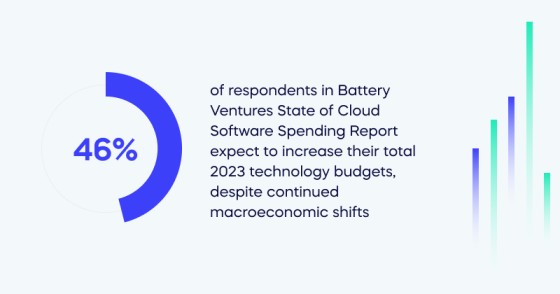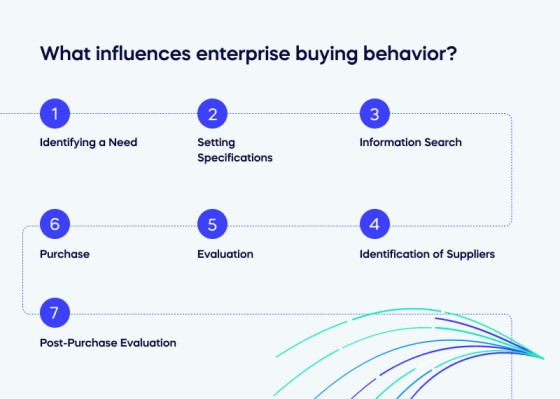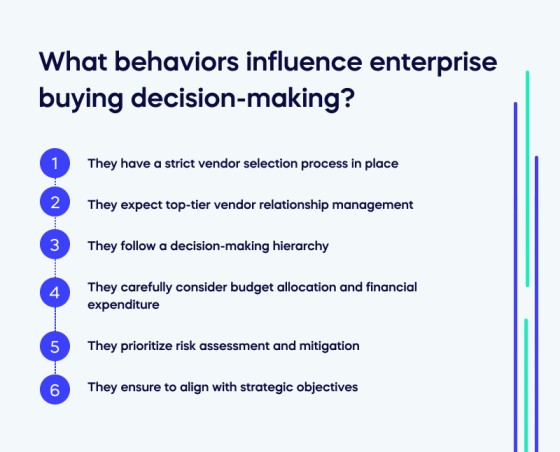With the need to reinvigorate how they operate and deliver value to their customers, companies industry-wide are becoming increasingly aware of digital transformation’s (DX) role in achieving this.
This digital innovation is best characterized by the proliferation of innovative technology solutions routinely entering the market.
Major technological disruptors such as cloud computing, artificial intelligence (AI), and blockchain technology are motivating more and more tech investments across various sectors.
46% of respondents in Battery Ventures State of Cloud Software Spending Report expect to increase their total 2023 technology budgets, despite continued macroeconomic shifts. The report finds that Cloud infrastructure is one of the fastest-growing areas in enterprise tech, as businesses increasingly rely on cloud-based services to store and process their data.

For CIOs, CDOs, and executive procurement officers, the pressure is on to make informed decisions when selecting B2B SaaS providers. With a deep understanding of buyer behavior, software vendors can confidently tailor their offerings, showcase their expertise, and address potential customers’ specific needs and pain points.
Recognizing the need for a deeper comprehension of this behavior, this article will delve into the intricacies of enterprise buying behavior, discussing its significance and key influences. It examines the reasons for observing this behavior and its impact factors. It concludes with advice on how vendors can effectively meet customer requirements.
What is enterprise buying behavior?
Enterprise buying behavior is the intricate interplay of decision-making processes businesses engage in when procuring goods or services.
It encompasses an array of factors, including financial considerations, supplier dynamics, technological alignment, market trends, and strategic objectives. This complex behavior involves thorough research, evaluation of options, negotiation, and ultimately selecting the most suitable solution to meet the organization’s needs.
Why observe enterprise buying behavior?
Given the technological potential presented, enterprises are keen to invest in adaptable and scalable solutions. They want technologies that can evolve with their business and broader market trends. This ensures technology investments are future-proof and they’re not left behind.
As per Statista, revenue in the global Public Cloud market is projected to exceed US$500 billion in 2023. Revenue is expected to show a CAGR of 13.81%, resulting in a market volume of US$881.80 billion by 2027. Software as a Service dominates the market with a projected market volume of US$253.90bn in 2023.
For B2B SaaS providers, in particular, understanding enterprise buyer behavior is essential for success. Whether considering how the buyer’s perception of the product due to shifting sales models can impact purchasing decisions or how buyer preferences and needs changes shape product development.
We must first look at their buying decision-making process to better understand what influences enterprise buying behavior.
What influences enterprise buying behavior?

Enterprise buying behaviors will largely correlate with a firm’s buying process – commonly referred to as the buying decision-making process.
At the starting point of the buying process sits need recognition. This is where the company identifies a gap between its current and desired state, thus recognizing a need for a purchase.
Following the recognition of a need, the process includes identifying the exact purchase requirements. This involves detailing the specific characteristics and features the product or service must possess to address the identified need.
After defining these requirements, extensive research is conducted to find products or services that meet these needs and provide the best value in terms of cost, quality, and reliability.
Need recognition is critical to the buying process when examining wider enterprise buying behaviors. It is the initial trigger that sets the entire process in motion. Understanding what triggers this need and how enterprises recognize it can offer valuable insights into their buying behaviors.
By observing the purchase decision-making processes of target customers, vendors can discern a common starting point and form a holistic understanding of enterprise buying behavior.
However, it’s important to note that while need recognition is crucial, it’s not the only aspect to consider. Each stage of the buying process – from need recognition to information search, evaluation of alternatives, purchase decision, and post-purchase evaluation – offers its own unique insights into enterprise buying behaviors.
Below we’ve detailed how closely observing each step in the enterprise buying process can enhance our understanding of buying behavior in general:
- Identifying a Need: As we mentioned, this is the first step where a business identifies a need or problem that requires a solution. It could be a gap in their current operations, a new project, or an upgrade to existing systems. Identifying enterprise needs in the buying journey allows vendors to gain insights into the pain points, challenges, and emerging requirements that influence enterprise buying behavior.
- Setting Specifications: Observing how enterprises set their specifications can reveal what they prioritize in a product or service. This could include cost, quality, delivery time, vendor support, etc.
- Information Search: Watching how enterprises search for information can show where they look for solutions and what sources they trust. This could guide marketing efforts to reach these enterprises.
- Identification of Suppliers: Understanding how enterprises identify potential suppliers can provide insights into what criteria they use for initial consideration, such as reputation, previous experience, or referrals.
- Evaluation: Observing the evaluation process can shed light on how enterprises compare different offerings and what factors influence their final decision. This can help vendors align their offerings with these key decision factors.
- Purchase: Monitoring the final decision-making stage can uncover what triggers a purchase or leads to a decision not to buy.
- Post-Purchase Evaluation: Studying post-purchase evaluation can help understand customer satisfaction levels, the likelihood of repeat business, and areas for improvement in product or service delivery.
Gartner explored pessimist buyers based on respondents agreeing, “We regret nearly every software purchase we make after the subscription agreement is finalized.” Their research found pessimists are skeptical when interacting post-sale, with 90% agreeing that vendor programs are more focused on getting them to spend more than helping them be successful with what they have.
What behaviors influence enterprise buying decision-making?

In the enterprise buying process, internal behaviors significantly influence how organizations approach vendor evaluation and selection.
These dynamics foster a comprehensive consensus of potential vendors, ensuring the chosen ones align well with the organization’s needs and objectives.
Enterprises typically follow a meticulous procedure that goes beyond just assessing the cost-effectiveness of a product or service. They delve deeper into long-term value, risk management, and the potential for a mutually beneficial relationship.
Moreover, enterprises appreciate vendors who can tailor their offerings to address specific pain points, thereby enhancing the overall buying experience. This focus on customization not only addresses the immediate needs but also ensures adaptability to future requirements.
Comprehending these internal behaviors can provide valuable insights for B2B companies such as Software-as-a-Service (SaaS) providers or industrial equipment manufacturers.
This understanding allows them to sculpt their offerings in a way that resonates with the specific challenges and operational nuances of their enterprise clients. It paves the way for innovative solutions that not just fulfill but anticipate and shape the evolving demands of the enterprise arena.
Below we’ve compiled the top six internal enterprise buying behaviors that influence the buying decision-making process:
- They have a strict vendor selection process in place
Enterprises operating across multiple verticals often use a rigorous vendor selection process to guide purchasing decisions.
The vendor selection process involves researching, evaluating, and assessing potential vendors based on their reputation, expertise, track record, financial stability, and compatibility. It includes exploring industry publications, online resources, customer reviews, and case studies to gather insights about vendors, products, and services.
After that, a systematic evaluation is conducted, considering price, quality, features, functionality, performance, scalability, and compatibility with existing systems.
This process serves as a valuable starting point for B2B companies, enabling them to gain insights into enterprise buying behavior and better tailor their products to meet the specific needs of their target market.
- They expect top-tier vendor relationship management
Building and maintaining strong relationships with vendors is crucial for enterprises. This behavior includes effective communication, negotiation, and vendor collaboration throughout the buying process to ensure alignment and mutual success.
- They follow a decision-making hierarchy
Enterprises follow a defined decision-making hierarchy, which can vary based on the organizational structure. This hierarchy determines the roles and responsibilities of individuals involved in the buying decision, such as procurement teams, department heads, executives, and stakeholders.
- They carefully consider budget allocation and financial expenditure
Enterprises carefully consider their budget allocation and financial constraints when making buying decisions. They assess the affordability, value-for-money, and return on investment of potential purchases to ensure they align with their financial goals.
- They prioritize risk assessment and mitigation
Enterprises assess the risks associated with purchasing decisions and develop strategies to mitigate those risks. This includes evaluating factors like vendor stability, product reliability, data security, compliance, and potential disruptions to operations.
The 2022 Verizon Data Breach Investigations Report, which analyzed over 23,000 security incidents and 5,000 breaches, found that 62% of system intrusions originated from partners, including third parties, vendors, and suppliers. Such breaches can lead to non-compliance penalties, regulatory actions, and a loss of customer trust.
- They ensure to align with strategic objectives
Enterprises align their buying decisions with their strategic objectives and long-term goals. They consider how a particular purchase supports their business strategy, enhances competitiveness, improves operational efficiency, or fosters innovation.
How can vendors best meet customer requirements?
Mastering the intricate dynamics of the enterprise sales landscape requires a delicate balance of strategy, adaptability, and genuine connection.
Comprehending enterprise buying behavior provides a unique insight into the nuanced preferences of prospective customers. This enables service providers to cultivate bespoke customer relationships in a targeted and personalized way.
Reflecting on the fact, this should serve as a compass for companies, guiding them toward effective strategies that resonate with potential buyers and foster lasting connections.
Statista reports that in Q4 2022, Amazon Web Services dominated the cloud market with a 32% share, followed by Microsoft Azure at 23%, and Google Cloud at 10%. Together, these three accounted for 65% of the total market.
By continuously seeking new insights, embracing innovation, and approaching every interaction with authenticity, businesses can forge their own unique path to success in the realm of enterprise B2B sales.


